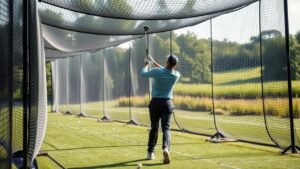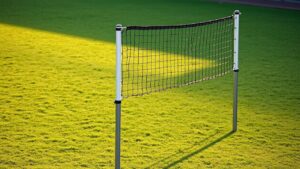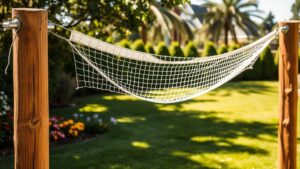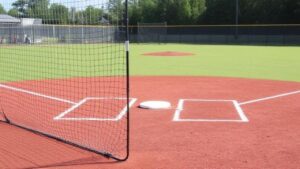In the world of sports, safety and performance are paramount. Whether you’re managing a professional stadium, a community sports complex, or a school athletic field, ensuring the safety of players, spectators, and property is a top priority. One of the most effective ways to achieve this is through the installation of sports barrier netting systems. These systems are designed to contain balls, pucks, and other equipment within the playing area, protect spectators from errant projectiles, and even prevent unauthorized access to restricted areas. In this comprehensive guide, we’ll explore everything you need to know about sports netting, from their benefits and types to installation and maintenance.
What Are Sports Barrier Netting Systems?
Sports barrier netting systems are specialized nets designed to create a physical barrier around sports fields, courts, and other athletic areas. They are commonly used in a variety of sports, including baseball, soccer, golf, tennis, and hockey. These nets are typically made from high-strength materials such as polyethylene, nylon, or polyester, which are chosen for their durability, UV resistance, and ability to withstand harsh weather conditions.
The primary purpose of sports barrier netting systems is to enhance safety by preventing balls or other equipment from leaving the playing area and potentially causing injury or damage. Additionally, these systems can be used to define boundaries, protect spectators, and even improve the overall aesthetics of a sports facility.

Benefits of Sports Barrier Netting Systems
Enhanced Safety
The most obvious benefit of sports barrier netting systems is the enhanced safety they provide. By containing balls and other equipment within the playing area, these nets significantly reduce the risk of injury to players, spectators, and nearby property. For example, in baseball, a foul ball can travel at high speeds and pose a serious danger to fans seated close to the field. A properly installed barrier net can prevent such incidents, ensuring a safer environment for everyone.
Property Protection
Sports barrier netting systems also protect property from damage. In sports like golf or baseball, errant shots can easily break windows, damage vehicles, or harm other structures. By installing a barrier net, you can prevent these costly accidents and maintain the integrity of your facility.
Improved Game Play
Barrier nets can also improve the quality of game play. In sports like soccer or tennis, a net can prevent balls from leaving the field, reducing interruptions and keeping the game flowing smoothly. This is particularly important in competitive settings where every second counts.
Aesthetic Appeals
Modern sports barrier netting systems are designed to be both functional and visually appealing. With a variety of colors, mesh sizes, and installation options available, you can choose a netting system that complements the overall design of your facility. This not only enhances the appearance of your sports complex but also creates a more professional and inviting atmosphere for players and spectators alike.
Types of Sports Barrier Netting Systems

There are several types of sports barrier netting systems available, each designed to meet specific needs and requirements. Here are some of the most common types:
Baseball and Softball Netting
Baseball and softball nets are designed to contain balls within the field of play and protect spectators from foul balls and home runs. These nets are typically installed behind home plate and along the baselines, extending high enough to catch any balls that might otherwise leave the field. They are usually made from heavy-duty materials to withstand the impact of high-speed balls.
Golf Netting
Golf nets are used to contain golf balls within the driving range or practice area. These nets are often installed around the perimeter of the range and can be quite tall to catch even the longest drives. Golf nets are typically made from durable materials that can withstand repeated impact from golf balls.
Soccer and Football Netting
Soccer and football nets are used to contain balls within the field of play and prevent them from entering spectator areas. These nets are usually installed around the perimeter of the field and can be customized to fit the specific dimensions of the playing area. They are designed to be highly visible, ensuring that players can easily see the boundaries of the field.
Tennis Netting
Tennis nets are used to contain tennis balls within the court and prevent them from entering adjacent courts or spectator areas. These nets are typically installed around the perimeter of the court and can be customized to fit the specific dimensions of the playing area. Tennis nets are usually made from lightweight materials that allow for easy installation and removal.
Multi-Sport Netting
Multi-sport nets are designed to be versatile and can be used for a variety of sports and activities. These nets are often installed in multi-use facilities where different sports or activities may take place in the same space. Sports netting technology are typically made from durable materials that can withstand the impact of different types of balls and equipment.
Factors to Consider When Choosing Sports Barrier Netting Systems
When selecting a sports barrier netting system, there are several factors to consider to ensure that you choose the right solution for your facility. Here are some of the most important factors to keep in mind:
Material
The sport net materials is one of the most important factors to consider. The material should be durable, UV-resistant, and able to withstand the impact of balls or other equipment. Common materials used in sports barrier netting systems include polyethylene, nylon, and polyester. Each material has its own advantages and disadvantages, so it’s important to choose one that meets your specific needs.
Mesh Size
The mesh size of the netting is another important consideration. The mesh size should be small enough to contain the balls or equipment used in your sport, but large enough to allow for adequate airflow and visibility. For example, a smaller mesh size is typically used for golf nets to prevent golf balls from passing through, while a larger mesh size may be used for soccer nets to allow for better visibility.
Height and Length
The height and length of the netting will depend on the specific requirements of your facility. For example, baseball nets are typically taller to catch high-flying balls, while soccer nets may be shorter but longer to cover the perimeter of the field. It’s important to measure your playing area carefully and choose a netting system that provides adequate coverage.
Installation Method
The installation method is another important factor to consider. Some netting systems are designed to be permanently installed, while others are portable and can be easily moved or removed. Permanent installations are typically more secure and durable, but portable systems offer greater flexibility and can be used in multiple locations.
Customization Options
Many sports barrier netting systems offer customization options, such as different colors, logos, or branding. Customization can enhance the appearance of your facility and create a more professional and inviting atmosphere. If customization is important to you, be sure to choose a netting system that offers these options.
Budget
Finally, budget is an important consideration when choosing a sports barrier netting system. The cost of the netting will depend on factors such as the material, size, and customization options. It’s important to choose a netting system that fits within your budget while still meeting your safety and performance requirements.
Installation and Maintenance of Sports Barrier Netting Systems

Once you’ve chosen the right sports barrier netting system for your facility, the next step is installation and maintenance. Proper installation and maintenance are essential to ensure that your netting system performs effectively and lasts for many years.
Installation
The installation process will vary depending on the type of netting system you choose. Permanent installations typically require professional installation, as they involve anchoring the netting to the ground or surrounding structures. Portable systems, on the other hand, can often be installed by facility staff using simple tools and instructions provided by the manufacturer.During installation, it’s important to ensure that the netting is securely anchored and properly tensioned. Loose or sagging netting can reduce the effectiveness of the barrier and increase the risk of injury or damage. If you’re unsure about the installation process, it’s always best to consult with a professional.
Maintenance
Regular maintenance is essential to keep your sports barrier netting system in good condition. This includes inspecting the netting for signs of wear or damage, such as frayed edges, holes, or loose fittings. Any damaged sections should be repaired or replaced as soon as possible to maintain the integrity of the barrier.In addition to visual inspections, it’s important to clean the netting regularly to remove dirt, debris, and other contaminants. This can be done using a mild detergent and water, or with a specialized netting cleaner. Avoid using harsh chemicals or abrasive materials, as these can damage the netting.Finally, it’s important to check the tension of the netting periodically and make any necessary adjustments. Over time, the netting may stretch or loosen, reducing its effectiveness. By maintaining proper tension, you can ensure that your netting system continues to provide the safety and performance you need.
Conclusion
Sports barrier netting systems are an essential component of any sports facility, providing enhanced safety, property protection, and improved game play. With a variety of types and customization options available, there’s a netting system to meet the needs of every facility. By carefully considering factors such as material, mesh size, and installation method, you can choose the right netting system for your facility and ensure that it performs effectively for years to come.
Whether you’re managing a professional stadium, a community sports complex, or a school athletic field, investing in a high-quality sports barrier netting system is a smart decision that will benefit players, spectators, and property alike. So why wait? Start exploring your options today and take the first step toward creating a safer, more enjoyable sports environment for everyone.











